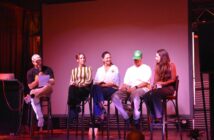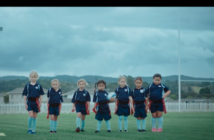While RNZ exists on the periphery of the commercial world, the organisation’s chief executive sees it as increasingly important to work with the nation’s major media companies.
On what RNZ does:
We know we have a role to play. And that role is becoming more important because of the shrinking of some of the resourcing, but I think the way through is to work together to get some of that diversity. I want to make sure that we’re one of the sources of valued information. It’s a great challenge and privilege having this role to play, but we don’t see it as something we do by ourselves. We’re very much a part of the media as a whole. A very small of example of this would be a sensible approach to radio ratings [which now also include RNZ]. And I think we’ll see more of that in the future.
On integration across the organisation:
I think that’s a really critical thing. We really have said that it’s not about our internal siloes. It’s about what’s best for the audience and best for the story. So I think a key aspect of it is that we have really good leaders who are working together, encouraging and facilitating the staff to think about all of the audience when things happen. Look, there are some tensions in there. It still requires a lot of resource to produce really good mainstream radio programmes, such as Checkpoint, Morning Report or a significant day part like Nine to Noon. And those teams are very focused on their output, but they’re also doing digital work now. The newsroom itself is not only looking after those traditional radio outputs, but they’re also doing video and text reporting … So, I think what we’re doing is providing a very clear view that we’re going to put the audience and the story first. Our staff have just been exemplary in terms of putting themselves out there, giving it a crack and working really hard.
On quality:
We know that our cornerstone is around credible journalism and trusted news and current affairs. We just can’t lose sight of that. So while we want to grow audiences and reach groups that we’re not reaching at the moment, like younger New Zealanders, we have to do it from the basis of credibility. I think one of the most destructive forces on commercial media outlets is the race for traffic and volume, which in the end hasn’t created strong businesses and has in the process diluted some of the value proposition. I’m not blaming anyone for that, because I can absolutely understand what’s happening. They were looking for advertising to follow the eyeballs, and we all know that’s not going to happen now. But in the process there has been quite a bit of damage done to the depth and quality of the news. We’re not high-minded about it, and we don’t look down on anyone else, but we know that our job is to provide New Zealanders with a clear choice around credible, thoughtful, curious and intelligent content.
On clickbait:
It’s the very thing we want to avoid. For us, it’s about the quality of the engagement and the fact that our journalism and programming is unique and distinct from what others are creating. It really is a trap for us to fall into a mindset where we’re too worried about either online ratings or traffic. We have to pay mind to them, but we take a broad view of making sure that we’re fulfilling our charter and doing high quality, relevant work that makes the whole media scene in New Zealand better, because we’re filling some of the gaps.
On collaboration with commercial players:
It’s one of the most positive things happening. And we need good news around media. It’s really important. Competition is healthy, and one of the major risks around the NZME-Fairfax proposed merger is the loss of some of that competition. But I think on some stories, co-operation, partnerships and collaboration trumps the old fashioned competition. The point there is that news is not something you can keep to yourself these days. An exclusive only lasts until someone rips it off and puts it on their website. And if you think of a significant public issue, you can actually get more audience engagement by working together. It’s not a zero sum game. I think journalism doesn’t need to be confined to one person’s audience, brand or platform. If you work together, you actually grow interest and engagement in important issues. So I think it’s going to be a major flavour not just for RNZ, but for a lot of other brands. In fact, we have a bit more luxury, because we don’t have to fiercely protect our revenue. We don’t mind where the stories go at the end. Just as long as we’re part of it and our journalists are adding to what people are experiencing.
On online expansion:
We’re still growing really fast on RNZ.co.nz. Users in April were 75 percent higher than they were a year ago, and we’re getting up to 1.2 million users a month. Obviously, not all users are individual. People use different devices, but we think that’s really strong growth. What we like about it is that we’re doing that by showcasing high-quality content, not by chasing clicks. We don’t want to grow for the hell of it, but we are seeing a younger audience engage with RNZ through that digital growth, and we know that’s a really important part of what we need to do.
On reaching the young’uns:
Our radio audiences are on the older side. Talk radio, particularly, draws an older audience, and we want to look after those people. But with our strategy we’re also looking to bring younger people into the fold. And I don’t really mind whether they come to us via Morning Report or if they come to us through a piece of content they really value. We just think it’s fantastic that people are getting exposed to what we do. And what we often find is that many people are surprised by how relevant and high-quality our work is. It’s just very heartening to see that happening. What we’re clearly seeing is that growth that we’re getting online is from a new bunch of people who aren’t coming to us on air. The Wireless is at the even younger end and it’s doing a really good job of providing high-quality, magazine-style reporting for younger people … The Wireless is a great example of us making sure that we’re investing our money and resources into work that’s distinctive and that no one else is doing.
On the proposed merger:
I should point out that it’s been two and half years since I left Fairfax, so I’m certainly not aware of the ins and outs. But I think that as an idea, a tie-up between those two entities was always a possibility at some point, as profitability was eroded. They have been struggling to get to a stable long-term business model. It was always on the cards, but I’m surprised it’s happened so quickly. But I think that speaks to the fact that the pace of change has quickened in the media, particularly around revenue lines. Both companies are still profitable, but I guess the thinking is that it’s better to do it now while that’s still the case rather than do it in two or three years time when it might not be the case. I think it’s an enormous shakeup, which could be hugely significant in terms of its potential impact on the range of news and views for New Zealanders. And a lot will depend on how the merger is done, but there certainly is a risk that there will be a significant decline in the variety and diversity of news that’s available. If it does get the go-ahead, there will be four major media companies: the new tie-up, TVNZ, MediaWorks and RNZ. And I think we should all be looking to collaborate and work smartly together to keep that diversity going. And I will certainly be talking with all the organisations over the next few months to find out how RNZ can help. Each of us has to do well in our own way, but we should also be working together to make sure that diversity of news and information is still available. And I think there’s an appetite to at least see whether we can make that happen.
On the importance of culture:
Culture is integral to a successful organisation of any type. Of course, the cultural attributes of success for media organisations in the past were built around maintaining standards and stability and producing work in a continuous way; for example, a daily newspaper or a daily radio show. A lot of the culture was based on stability and maintaining the status quo. But the real sharp end of the newsrooms today is agility, flexibility, innovating, trying things and failing fast. These attributes have been more important than those older attributes focused on stability. That’s a massive change. I think the biggest challenge that I have at RNZ is creating a culture that supports the new RNZ strategy. I’ve talked with staff about this, and I’ve said that there’s a lot we can do on this. And it’s going to be the focus for me over the next two years. If you don’t get your culture right, you’ll really, really struggle.
On the lack of diversity in media:
There’s no question that one of the major challenges we face in the media industry is reaching those diverse audiences with constrained resources while still trying to look after our traditional audiences. It’s really hard. I think there are some good things happening in pockets, like some of the partnerships that some of the commercial players are entering into is a good example of that. But we’re really just scratching the surface. One of the big problems we face is that our newsrooms and our staffing profiles don’t reflect the wider New Zealand community. And if any media organisation wants to have a long-term future, we’re going to have to address that question of both the diversity of our staffing and the diversity and relevance of our content to these new groups. New Zealand is changing very rapidly. Auckland is the most intense example of that, but it’s mirrored across the country. For RNZ, it’s a massive challenge and there’s no quick fix. It’s something you need to invest in on a long-term basis, and we’re starting to think about how we’re going to do that.
On staying positive:
There probably are green shoots appearing [in media]. It’s not all doom and gloom, although it can feel like it at times. There are some really good things happening around news forms of content delivered in new ways. A lot of the constraints that used to limit media organisations have come off and a new world will develop over the next few years. The difficulty is that we’re not yet there, and in the meantime the old world is crumbling a bit.
I think one of the positives of the proposed merger is the creation of a New Zealand media organisation that’s not run from across the Tasman, so there are also opportunities for us
to build something that will be good.
- This story first appeared in the Media edition of NZ Marketing.




